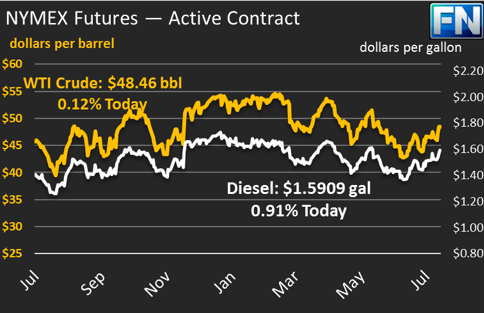
Today’s Market Trend
Crude prices are $48.46/bbl this morning, lacking strong directionality following yesterday’s nearly flat trading. Prices rose a mere $.24, or .49%, following the release of the EIA data, which was decidedly less bullish for crude prices than Tuesday’s API report. Still, yesterday’s report confirmed that inventories are finally below 2016 levels for this time of year. Prices have given up yesterday’s gains, shedding $.29 (.59%) since yesterday’s closing price.
Diesel and gasoline prices received a larger boost than crude did from the EIA data. While the API showed a very slight draw in diesel stocks and a surprise build for gasoline, the EIA showed solid draws for both products. Both diesel and gasoline gained 1.1% yesterday. Today, prices are down slightly from yesterday’s close, with diesel falling $.0044 (.28%) to reach $1.5905, and gasoline falling just $.0001 (.01%) to reach $1.6172.
The U.S. Dollar is down sharply this morning, opening at its lowest level since May 2016, which is helping to keep oil prices high. Speculative positions have fallen to a net short, also for the first time since May 2016. Yesterday, the Federal Reserve announced no change in interest rates this quarter. They also announced their intention to begin reducing the size of their balance sheet, which normally would support the dollar, but they qualified the statement by saying action was dependent on continued growth of the U.S. economy. With President Trump busy combating news about Russia, he’s been hampered from enacting most of the pro-growth policies promised during his campaign, and markets are showing their concern. All this comes as the IMF reduced its projections of U.S. economic growth in 2017 from 2.3% to 2.1%, while maintaining its forecast for the world economy.
Yesterday, the U.S. imposed sanctions on thirteen Venezuelan senior officials. The Venezuelan government, being led by Nicolas Maduro, is soon to elect officials to re-write the Venezuelan constitution, which many are saying will be used to make the country more dictatorial. The U.S. warned that if Maduro goes through with the elections, we would impose harsher sanctions targeted at their economy, including oil sanctions. If the U.S. does issue oil sanctions against Venezuela, which is the third largest source of U.S. oil imports, oil prices will certainly rise.
As geopolitical risks have been on the rise, it’s helpful to review a few critical areas through which millions of barrels of oil flow every day. This week, the EIA updated their World Oil Transit Chokepoints list, identifying some key locations for oil markets. Today’s second article shares the EIA’s analysis.
This article is part of Crude
Tagged:
MARKET CONDITION REPORT - DISCLAIMER
The information contained herein is derived from sources believed to be reliable; however, this information is not guaranteed as to its accuracy or completeness. Furthermore, no responsibility is assumed for use of this material and no express or implied warranties or guarantees are made. This material and any view or comment expressed herein are provided for informational purposes only and should not be construed in any way as an inducement or recommendation to buy or sell products, commodity futures or options contracts.







